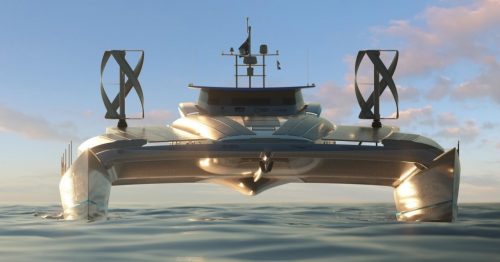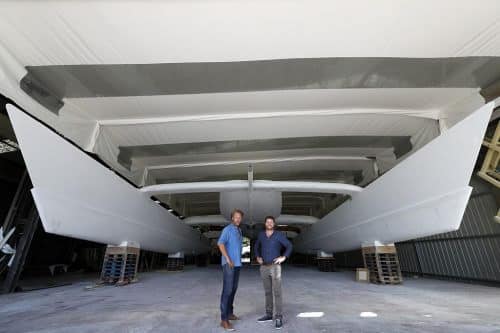After the success of the solar plane, a new initiative to circumnavigate the globe in a catamaran boat that uses only renewable energies is in its final stages. Along the way, will the green sailors succeed in convincing the public that the future is in a fuel cell on the right?

by Assaf Ben Naria, angle, news agency for science and the environment
Long before man started distilling oil in millions of gallons and burning huge amounts of fuels to drive the wheels of civilization, he knew how to use a variety of green and renewable energies that nature offers: the wind, the water flowing in rivers, etc. Today it seems that we invest a lot of time, money and effort just to develop new technologies that will cut us off from the binding dependence on fuels and return and utilize the energies that exist "freely" in nature.
This is exactly what the "Energy Observer". The boat, which was named "Solar-Impulse of the Sea" after the plane who recently completed the circumnavigation of the world Powered by the sun, it sails using only renewable energies and is supposed to circumnavigate the world without using fuel.
The sea voyage to circumnavigate the world, which will be led by the entrepreneurs and co-skippers Victorien Arosar and Jérôme Delafus, is planned to take no less than six years, and the cost is estimated at 30 million dollars, of which 4.7 million to cover construction and development costs and no less than 4.4 million in travel expenses every year. The initiators of the journey hope that the technologies they will use to sail will increase the awareness of renewable energies among the 50 countries where the boat is expected to pass, but mainly they would like to convince the decision makers that it is not just a gimmick, but an environmentally and economically sensible alternative.
Sun, wind and hydrogen
The Energy Observer is 30 meters long and 13 meters wide. This is a type of boat catamaran, who previously won the competition Jules VerneFor the circumnavigation of the world in a period of 75 days, which is currently undergoing a series of upgrades that will make it the first boat in the world to circumnavigate the earth using electric energy and whose carbon footprint is equal to zero.
The upgrades include the installation of solar panels over an area of 130 square meters, the placement of two vertical wind turbines and the replacement of the propulsion system for a tram.
The most interesting innovation in the green boat is a system for producing hydrogen from water. The innovative system will use the excess electricity from the renewable energy systems to produce hydrogen from seawater. Thus, technology The right fuel compartment You will supply electricity to the boat during the hours when the sun and winds will not allow electricity generation.
A series of hydrogen fuel cells will provide electricity to the boat's engines, whose only exhaust product will be water. In this way, the hydrogen is actually used as a kind of big battery where you can store available energy that is produced mainly by the power of the sun's rays during the day and which will be used during the night.
The means of propulsion of the future?
A hydrogen fuel cell works much like a regular battery, with one key difference: it doesn't need charging. As long as the hydrogen supply to the cell continues, energy production continues. A hydrogen fuel cell works by flowing the hydrogen gas (the hydrogen molecule consists of two hydrogens and its symbol H2) through a catalyst where it breaks down into positive and negative ions. First, all the hydrogen ions are on the side called the anode, the negative side, and only the positively charged ones are able to move to the positive side, called the cathode. The passage of the positive charges, the protons, occurs through a membrane that allows the passage of only protons. This creates an electric voltage between the different sides and the electrons from the anode side are directed to an external electric circuit, which creates the electric current that drives the motor. On the cathode side, hydrogen ions combine with oxygen and water molecules are formed.
Ostensibly, this is a completely green process and applicable from an engineering point of view. So why don't we see hydrogen fuel cell cars flooding the roads? The main reason for this is that hydrogen is not found freely in nature and will always be bound to another substance, such as in water molecules (H2O), in organic compounds such as fossil fuels, gas and coal. The process of separating hydrogen is energetically expensive and in most cases its production is done by using fossil fuels. To this must be added the safety problems of storing hydrogen in high pressure tanks inside the vehicles close to the passenger cabin.

Technological innovations for hydrogen production that do not use fossil fuels are available in development and there are methods for producing it using solar energy as well as in more unique methods such as for example by using itViruses and algae. The possibility of in-phase hydrogen storage Liquid will allow storage of larger quantities in smaller containers. Therefore, it is not surprising that the leading car companies have entered this field and from time to time we hear about a pilot vehicle that is powered by a fuel cell, such as the Toyota Mirai which is powered by hydrogen fuel cell technology. Its marketing began at the end of 2015 and it comes with a claimed range of 502 kilometers and a price tag of 57.5 thousand dollars (the car is not marketed in Israel).
Only 3% renew
The green boat is getting closer to the moment when it will lift anchor, but in Israel it seems that the road to reach the goal of 10 percent electricity production from renewable energies, a goal defined by the government for 2020, is still far away. The percentage of renewable energy production in 2016 is just over three percent and should rise to five percent in 2017, according to Report The state of the electricity sector for 2015.
A little more optimism can be found in the announcement by the Electricity Authority about the intention to open additional quotas for the production of electricity in solar facilities to the extent of 1,000 megawatts. For comparison, at the station Lights In Hadera, about 2,600 megawatts are produced, with the energy source for this being coal. Even further is the goal of reducing greenhouse gas emissions - 25 percent by 2030. The goals are part of a government decision made in preparation for Paris conference which took place last year, in which the powers adopted a new global climate agreement.
In April 2017, if there are no last-minute changes, the Energy Observer will depart from the port city of Saint-Malo in northwestern France. "To reduce our negative impact on the planet without harming the quality of life", is the motto engraved on the flag of the group of entrepreneurs and engineers who stand behind the project. Will what is possible on the surface of the sea someday become a reality on the surface of the land? This question will accompany us throughout the six-year journey around the world, and probably much beyond that.
A video presenting the project:

2 תגובות
And hydrogen is not an energy source. Just a way to store and transport energy.
It's also a shame that they didn't address the problem of the price of fuel cells.
A price problem arising from the use of expensive and rare materials such as platinum. (This is a serious problem that must be solved. This is not a normal expensive price for new technology, something that should decrease over time)
On the other hand, there are studies on new battery technologies that, although still far away, at least theoretically reach the energy density of gasoline.
On the other hand, there are advantages to hydrogen that batteries do not have.
Like for example if you want to store a very large amount of energy (say next to a green power plant that produces energy irregularly) then using batteries you can only store until the batteries are full and that's it. If you store hydrogen, you can empty part of the tank and tell the seller the excess.
Just an insignificant gimmick.
It makes more sense to produce a merchant that only 10-20 percent of its energy is green.
There is nothing new about it either. Sailing ships have already circled the world in seas of air pollution